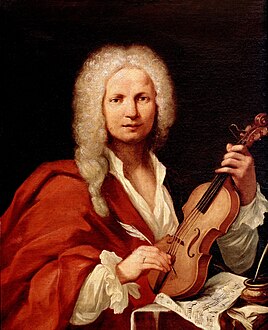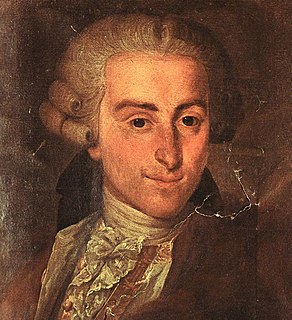Related Research Articles

Antonio Lucio Vivaldi was an Italian Baroque composer, virtuoso violinist, teacher, impresario, and Roman Catholic priest. Born in Venice, the capital of the Venetian Republic, Vivaldi is regarded as one of the greatest Baroque composers, and his influence during his lifetime was widespread across Europe, being paramount in the development of Johann Sebastian Bach's instrumental music. He composed many instrumental concertos, for the violin and a variety of other musical instruments, as well as sacred choral works and more than forty operas. His best-known work is a series of violin concertos known as the Four Seasons.
A mandolin is a stringed musical instrument in the lute family and is generally plucked with a plectrum. It most commonly has four courses of doubled metal strings tuned in unison, thus giving a total of 8 strings, although five and six course versions also exist. The courses are typically tuned in a interval of perfect fifths, with the same tuning as a violin. Also like the violin, it is the soprano member of a family that includes the mandola, octave mandolin, mandocello and mandobass.

Tomaso Giovanni Albinoni was an Italian Baroque composer. His output includes operas, concertos, sonatas for one to six instruments, sinfonias, and solo cantatas. While famous in his day as an opera composer, he is known today for his instrumental music, especially his concertos. He is also remembered today for a work called "Adagio in G minor", attributed to him but said to be written by Remo Giazotto, a modern musicologist and composer, who was a cataloger of the works of Albinoni.

Giovanni Battista Draghi, often referred to as Giovanni Battista Pergolesi, was an Italian Baroque composer, violinist and organist. His best-known works include his Stabat Mater and the opera La serva padrona. His compositions include operas and sacred music. He died of tuberculosis at the age of 26.

A symphony is an extended musical composition in Western classical music, written by composers, most often for orchestra. Although the term has had many meanings from its origins in the ancient Greek era, by the late 18th century the word had taken on the meaning common today: a work usually consisting of multiple distinct sections or movements, often four, with the first movement in sonata form. Symphonies are almost always scored for an orchestra consisting of a string section, brass, woodwind, and percussion instruments which altogether number about 30 to 100 musicians. Symphonies are notated in a musical score, which contains all the instrument parts. Orchestral musicians play from parts which contain just the notated music for their own instrument. Some symphonies also contain vocal parts.
The trio sonata is a genre, typically consisting of several movements, with two melody instruments and continuo. Originating in the early 17th century, the trio sonata was a favorite chamber ensemble combination in the Baroque era.

Ridolfo Luigi Boccherini was an Italian, later Spanish, composer and cellist of the Classical era whose music retained a courtly and galante style even while he matured somewhat apart from the major European musical centers. He is best known for a minuet from his String Quintet in E, Op. 11, No. 5, and the Cello Concerto in B flat major. The latter work was long known in the heavily altered version by German cellist and prolific arranger Friedrich Grützmacher, but has recently been restored to its original version.

Giovanni Battista Viotti was an Italian violinist whose virtuosity was famed and whose work as a composer featured a prominent violin and an appealing lyrical tunefulness. He was also a director of French and Italian opera companies in Paris and London. He personally knew Joseph Haydn and Ludwig van Beethoven.

Giovanni Battista Sammartini was an Italian composer, violinist, organist, choirmaster and teacher. He counted Gluck among his students, and was highly regarded by younger composers including Johann Christian Bach. It has also been noted that many stylizations in Joseph Haydn's compositions are similar to those of Sammartini, although Haydn denied any such influence. Sammartini is especially associated with the formation of the concert symphony through both the shift from a brief opera-overture style and the introduction of a new seriousness and use of thematic development that prefigure Haydn and Mozart. Some of his works are described as galant, a style associated with Enlightenment ideals, while "the prevailing impression left by Sammartini's work... [is that] he contributed greatly to the development of a Classical style that achieved its moment of greatest clarity precisely when his long, active life was approaching its end".

Gaetano Pugnani was an Italian composer and violinist.
Giuseppe Francesco Gaspare Melchiorre Baldassare Sammartini was an Italian composer and oboist during the late Baroque and early Classical era. Although he was from Milan, most of his professional life was spent in London and with Frederick, the Prince of Wales.
Antonio Brioschi was an Italian symphony composer who wrote at least twenty six symphonies; most of which were preserved in the collection of Pierre Philibert de Blancheton.
Andrea Teodoro Zani was an Italian violinist and composer.
Antonio Maria Montanari was an Italian violinist and composer of the Baroque period.
Giuseppe Ferdinando Brivio was an Italian composer, conductor, violinist, and singing teacher who is chiefly known for his operas. His work displays a natural expression and uses figurations similar to that of Antonio Vivaldi.
Angelo Maria Scaccia was an Italian composer and violinist. He wrote fourteen concertos for the violin, including the major set of violin concertos, his Opus 1, a set of six,, the first published by a Milanese composer. He also published a single concerto in 1736. Most of his other surviving works are scattered across a range of manuscript collections; including Pierre Philibert de Blancheton's Fonds Blancheton.
Jérôme Paul Bonaventure Alday was a French violinist, composer and music publisher who spent most of his active career in Dublin, Ireland. He was the only composer in early 19th-century Ireland known to have written symphonies.
References
- 1 2 3 Antonio Brioschi (1998). Six symphonies, Volume 51. Madison, Wisconsin: A-R Editions, Inc. p. 56.
- 1 2 3 Jehoash Hirshberg (1984). Ten Italian violin concertos from Fonds Blancheton: Part 1. A-R Editions, Inc. p. vii. ISBN 9780895791719.
- ↑ Simon McVeigh and Jehoash Hirshberg (2004). The Italian Solo Concerto, 1700-1760: Rhetorical Strategies and Style History. Boydell & Brewer. p. 262. ISBN 9781843830924.